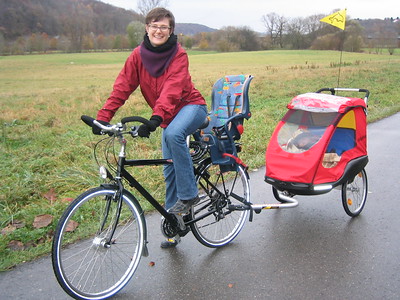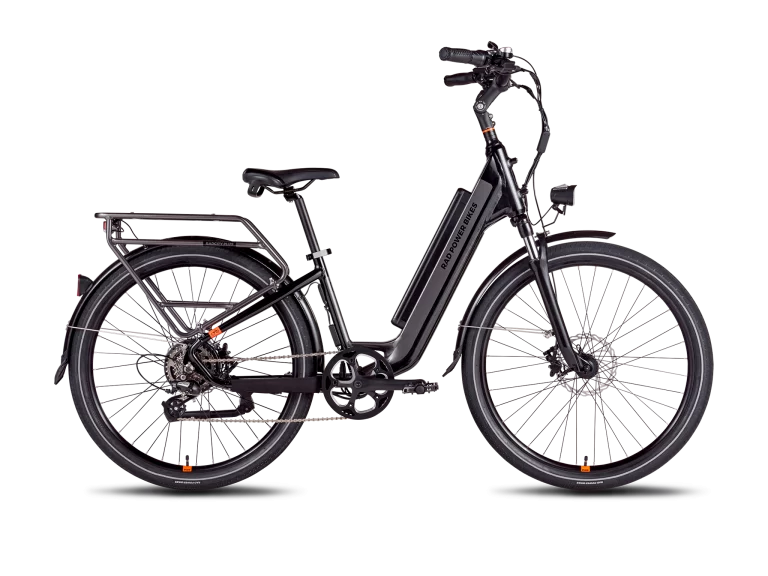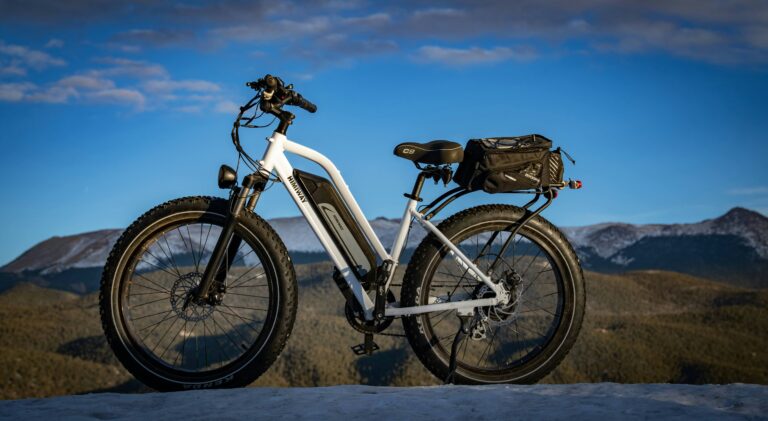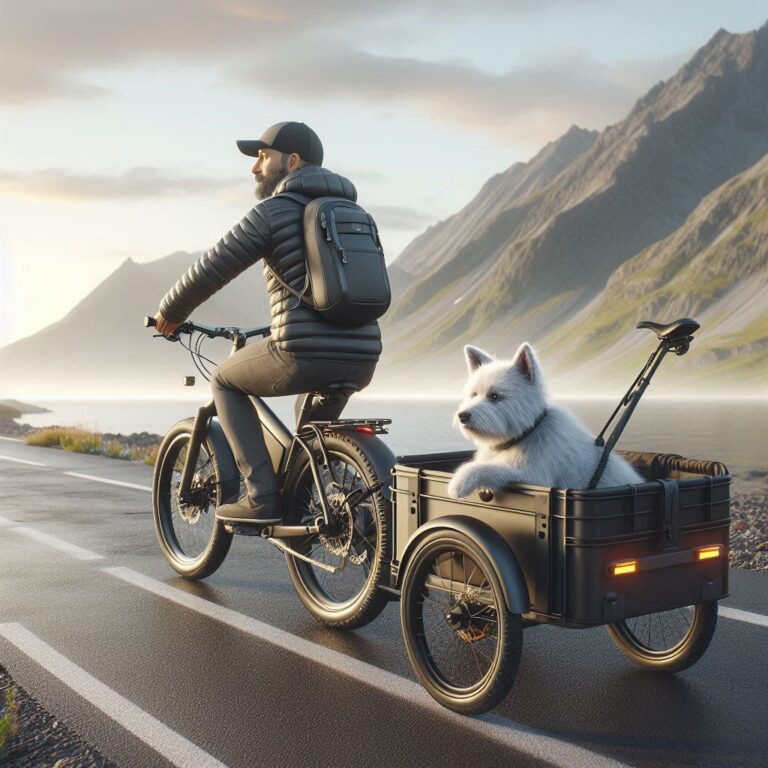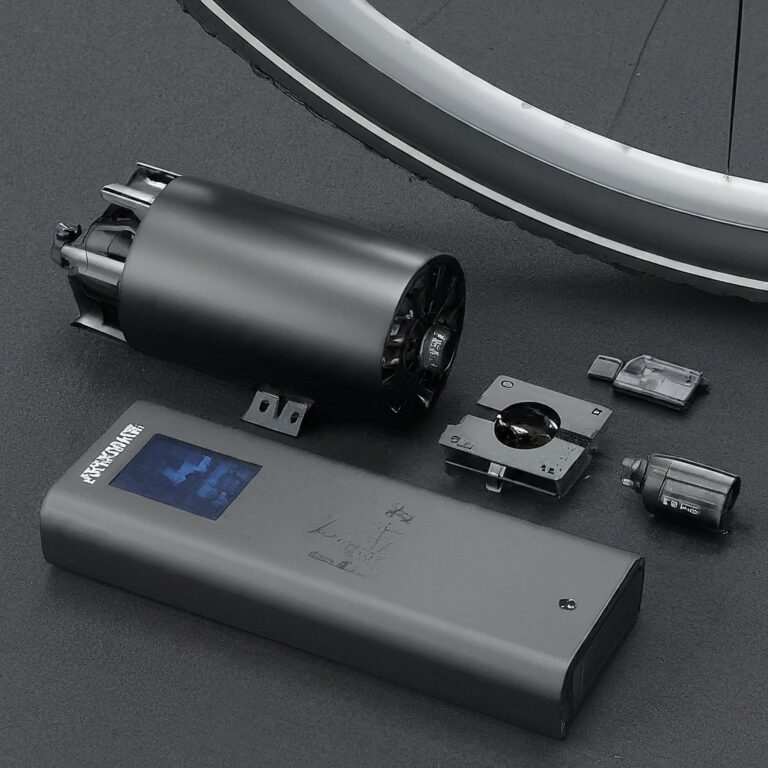Ultimate Guide: Safely Transporting Kids on Electric Bikes with Child Seats and Trailers
Last Updated on March 20, 2024 by Kristina Grant
As urban landscapes evolve and environmental consciousness grows, families are seeking innovative and sustainable modes of transportation. One emerging trend at the forefront of this movement is the use of electric bikes for family outings and daily commutes. In this article, we will learn about electric bike family transportation, specifically focusing on the feasibility and safety considerations of installing child seats or trailers on these modern marvels.
Electric bikes, or e-bikes, have revolutionized the way people navigate city streets and suburban roads alike. With their pedal-assist technology and eco-friendly attributes, they offer a compelling alternative to traditional automobiles. What’s more, their versatility extends beyond solo riders, accommodating families keen on exploring the world on two wheels.
Against this backdrop, the question arises: Can electric bikes serve as reliable platforms for transporting our most precious cargo—our children? This inquiry sparks a journey into the intricacies of equipping e-bikes with child seats or trailers, balancing the allure of convenience with the paramount importance of safety.
Throughout this exploration, we’ll navigate the growing popularity of electric bikes as a mode of family transportation, shedding light on the considerations that parents must weigh when contemplating the installation of child carriers. From understanding the mechanics of child seats and trailers to deciphering legal obligations and safety protocols, our aim is to equip you with the knowledge needed to make informed decisions for your family’s mobility needs. So let’s go on this journey together, discovering the possibilities and potential pitfalls of integrating electric bikes into the fabric of family life.
Key Takeaways:
- Safety First: Prioritize the safety of your children above all else. Ensure that child seats or trailers are installed correctly and securely, and always adhere to safety guidelines and regulations.
- Legal Compliance: Familiarize yourself with local laws and regulations regarding the transportation of children on electric bikes. Adhere to age, weight, and equipment requirements to ensure compliance and avoid potential legal issues.
- Compatibility Matters: Assess the compatibility of your electric bike with different child transport options. Consider factors such as weight capacity, attachment points, and clearance to select the most suitable option for your bike and family’s needs.
- Balance and Stability: Maintain balance and stability while riding with children on electric bikes. Distribute weight evenly, practice smooth handling, and be mindful of braking and cornering to ensure a safe and comfortable ride for everyone.
- Consultation and Professional Advice: When in doubt, seek guidance from professionals or experts in the field. Whether it’s regarding installation, safety concerns, or legal requirements, consulting with knowledgeable individuals can provide valuable insights and peace of mind.
Electric Bike Child Transport Options
Electric bikes offer versatile solutions for family transportation, with two primary options for carrying children: child seats and bike trailers. Each option comes with its own set of benefits and drawbacks, catering to different preferences and needs.
Child Seats:
Benefits:
- Proximity: Child seats allow parents to keep their children close during rides, fostering a sense of connection and security.
- Compactness: Compared to trailers, child seats are generally more compact, making them suitable for navigating crowded urban streets and narrow bike paths.
- Cost-effectiveness: Child seats are often more affordable than bike trailers, offering a budget-friendly option for families.
Drawbacks:
- Limited Capacity: Child seats typically accommodate only one child, limiting their usability for families with multiple children.
- Weight Distribution: Placing a child seat on the rear rack or handlebars of an electric bike can affect the bike’s balance and stability, requiring careful consideration of weight distribution.
- Growing Out: Children may outgrow child seats relatively quickly, necessitating the purchase of larger seats or alternative transport solutions as they age.
RELATED CONTENT – Guide to Cargo Electric Bikes for Transporting Groceries and Kids
RELATED CONTENT – What are the Best Bike Racks for Electric Bikes?
Bike Trailers:
Benefits:
- Capacity: Bike trailers can accommodate multiple children, providing a practical solution for larger families or parents with multiple young children.
- Safety: Trailers offer a protective enclosure for children, shielding them from external elements and providing a secure riding environment.
- Versatility: Some bike trailers can double as strollers or joggers, offering multifunctionality for active families.
Drawbacks:
- Size and Bulkiness: Bike trailers are generally larger and bulkier than child seats, requiring additional storage space and maneuvering considerations.
- Cost: Bike trailers tend to be more expensive than child seats, representing a higher initial investment for families.
- Compatibility: Not all electric bikes are compatible with bike trailers, as some may lack the necessary attachment points or clearance for trailer hitches.
Compatibility Considerations for Electric Bikes:
When considering child transport options for electric bikes, compatibility is paramount. It’s essential to ensure that the bike can safely accommodate the chosen child carrier without compromising stability or performance. Factors to consider include:
- Weight Capacity: Check the electric bike’s weight capacity to ensure it can safely support the combined weight of the rider, child, and carrier.
- Attachment Points: Determine whether the bike has designated attachment points for child seats or trailers, ensuring secure installation.
- Clearance: Evaluate the bike’s frame geometry and wheel size to ensure adequate clearance for attaching and maneuvering the chosen child carrier.
- Stability: Consider the bike’s stability and handling with the added weight of a child carrier, especially when navigating hills or sharp turns.
By carefully assessing these compatibility considerations, parents can select the child transport option that best suits their electric bike and family’s needs, ensuring a safe and enjoyable riding experience for all.
Safety Tips for Electric Bike Child Carriers
Ensuring the safety of children while riding on electric bikes is paramount. Whether using child seats or trailers, following essential safety guidelines is crucial for a secure and enjoyable riding experience for both parents and children.
Installing and Using Child Seats or Trailers:
- Proper Installation: Always follow the manufacturer’s instructions for installing child seats or trailers on your electric bike. Ensure that the attachment points are secure and that the carrier is properly aligned with the bike frame.
- Securing Mechanisms: Double-check all securing mechanisms, including straps, buckles, and harnesses, to ensure they are fastened securely before each ride. Regularly inspect these components for signs of wear or damage.
- Weight Distribution: Distribute weight evenly when using child seats or trailers to maintain balance and stability. Avoid overloading the carrier or placing excessive weight on one side of the bike, which can affect handling and control.
- Visibility: Enhance visibility by outfitting the child carrier with reflective materials or accessories, especially when riding in low-light conditions or at night. Make sure that the bike’s lights and reflectors are functioning correctly.
RELATED CONTENT – Enhance the Comfort of Long Electric Bike Rides
Maintaining Balance and Stability:
- Practice Handling: Familiarize yourself with the handling characteristics of your electric bike when carrying children. Practice riding in a controlled environment before venturing onto busy streets or challenging terrain.
- Smooth Riding: Maintain a smooth and steady riding pace to minimize sudden movements or jolts that could startle or discomfort your child. Gradually accelerate and decelerate to provide a comfortable riding experience.
- Cornering Carefully: Approach corners and turns with caution, reducing speed as necessary to maintain control. Lean into turns gradually, keeping your movements fluid and predictable for your child’s comfort.
- Brake Responsibly: Use the brakes gently and evenly to avoid sudden stops or jerky movements that could destabilize the bike. Anticipate traffic conditions and plan your braking maneuvers accordingly.
Additional Safety Precautions:
- Helmet Use: Always insist on wearing helmets for both yourself and your child when riding on an electric bike. Ensure that the helmets fit properly and meet safety standards approved for cycling.
- Supervision: Maintain constant supervision of your child while riding on the electric bike, remaining attentive to their comfort and needs throughout the journey. Engage them in conversation to reassure and distract them as needed.
- Weather Considerations: Be mindful of weather conditions, such as wind, rain, or extreme temperatures, which can affect the safety and comfort of your child during rides. Dress them appropriately and consider postponing rides in adverse weather conditions.
By adhering to these safety tips and guidelines, parents can enjoy the benefits of electric bike transportation with their children while prioritizing their well-being and security on the road. Remember that safety is paramount, and proactive measures can make all the difference in creating lasting memories of family adventures on two wheels.
Legal and Regulatory Considerations
Navigating the legal landscape surrounding the transportation of children on electric bikes involves understanding relevant laws and regulations. From age and weight restrictions to mandatory safety equipment requirements, being informed about legal considerations is crucial for ensuring compliance and promoting the safety of young passengers.
RELATED CONTENT – Do you Know Where You Can Ride Your Electric Bike Legally?
Relevant Laws and Regulations:
- Age Restrictions: Many jurisdictions have specific age requirements governing the transportation of children on bicycles, including electric bikes. These regulations may stipulate a minimum age at which children can ride as passengers or operate their own electric bikes.
- Weight Restrictions: In addition to age restrictions, weight limits may apply to child carriers mounted on electric bikes. It’s essential to adhere to these limits to ensure the structural integrity of the bike and the safety of both the child and the rider.
- Traffic Laws: Electric bike riders must comply with traffic laws applicable to bicycles in their respective jurisdictions. This includes obeying traffic signals, yielding to pedestrians, and following designated bike lanes or paths.
Insights into Age and Weight Restrictions:
- Age Requirements: Consult local laws and regulations to determine the minimum age for transporting children on electric bikes. Some jurisdictions may specify a minimum age for riding as a passenger, while others may require children to reach a certain age before operating their own electric bikes.
- Weight Limits: Be aware of weight restrictions imposed by manufacturers for child seats or trailers. Exceeding these limits can compromise the safety and stability of the electric bike, increasing the risk of accidents or equipment failure.
Mandatory Safety Equipment:
- Helmets: Many regions mandate the use of helmets for cyclists, including children riding on electric bikes. Ensure that helmets worn by children meet safety standards approved for cycling and fit properly to provide adequate protection.
- Reflectors and Lights: Some jurisdictions require bicycles, including electric bikes, to be equipped with reflectors and lights for increased visibility, especially during low-light conditions or nighttime riding. Check local regulations to ensure compliance with these requirements.
- Safety Harnesses and Straps: Child seats and trailers should be equipped with safety harnesses or straps to secure children during rides. Verify that these safety features meet regulatory standards and are in good working condition.
By familiarizing themselves with legal and regulatory considerations, parents can navigate the complexities of transporting children on electric bikes safely and responsibly. Compliance with applicable laws and adherence to safety guidelines are essential for promoting a culture of cycling that prioritizes the well-being of young passengers and riders alike.
Top 5 Recommended Child Seats for Electric Bikes
1. Thule Yepp Maxi Child Bike Seat
Overview: The Thule Yepp Maxi Child Bike Seat is renowned for its innovative design and exceptional safety features. It’s designed to provide a comfortable and secure riding experience for children, making it an ideal choice for electric bike transportation.
Features:
- Quick and easy installation with a universal mounting system.
- Adjustable footrests and harness ensure a custom fit for children.
- Shock-absorbing materials for a smooth ride.
- Integrated rear reflector for enhanced visibility.
Specs:
- Weight Capacity: Up to 48.5 lbs (22 kg).
- Dimensions: 31.5 x 15.4 x 10.2 inches (80 x 39 x 26 cm).
- Weight: 9.7 lbs (4.4 kg).
Pros:
- Excellent build quality and durability.
- Comfortable for children, even on longer rides.
- Quick and easy mounting system.
- Compatible with most electric bikes.
Cons:
- Higher price point compared to some other options.
- May not fit well on bikes with certain frame designs.
User Review Statements:
- “My child loves riding in the Thule Yepp Maxi seat! It’s comfortable and secure, and I feel confident knowing they’re safe.”
- “Installation was a breeze, and the seat feels very sturdy on my electric bike. Highly recommend!”
Price and Where to Get:
- Price: $219.95 (may vary).
- Available at outdoor retailers like REI, Amazon, and the Thule website.
2. Hamax Caress Child Bike Seat
Overview: The Hamax Caress Child Bike Seat combines safety, comfort, and sleek design, making it a popular choice among parents for electric bike rides with their little ones.
Features:
- Adjustable recline function for customizable comfort.
- Shock-absorbing suspension system for a smooth ride.
- One-handed adjustable harness and footrests.
- Integrated helmet recess for added head support.
Specs:
- Weight Capacity: Up to 48.5 lbs (22 kg).
- Dimensions: 30.7 x 15.7 x 10.2 inches (78 x 40 x 26 cm).
- Weight: 13.2 lbs (6 kg).
Pros:
- Excellent suspension system for a comfortable ride.
- Easy-to-adjust harness and footrests.
- Sleek and modern design.
- Easy installation on most electric bikes.
Cons:
- Slightly heavier compared to some other options.
- May require additional adapters for certain electric bike models.
User Review Statements:
- “The Hamax Caress seat is worth every penny! It’s incredibly comfortable for my child, and the suspension system really makes a difference.”
- “Installation was straightforward, and the seat feels very secure on my electric bike. Highly recommend for any parent!”
Price and Where to Get:
- Price: $199.00 (may vary).
- Available at retailers like REI, Amazon, and the Hamax website.
3. iBert Safe-T-Seat Child Bike Seat
Overview: The iBert Safe-T-Seat Child Bike Seat offers a unique front-mounted design, providing a fun and interactive riding experience for children while maintaining safety and comfort.
Features:
- Front-mounted design allows for better interaction between parent and child.
- Quick and easy installation without the need for tools.
- Adjustable padded harness for a secure fit.
- Fits most adult bicycles, including many electric bike models.
Specs:
- Weight Capacity: Up to 38 lbs (17.2 kg).
- Dimensions: 20 x 14 x 10 inches (50.8 x 35.6 x 25.4 cm).
- Weight: 4.8 lbs (2.2 kg).
Pros:
- Front-mounted design enhances parent-child interaction.
- Lightweight and compact.
- Easy installation and removal.
- Fits most electric bikes without additional adapters.
Cons:
- Lower weight capacity compared to some other options.
- Limited recline options for child comfort.
User Review Statements:
- “We love the iBert Safe-T-Seat! It’s so much fun riding with our child in front, and they love the view.”
- “Installation was a breeze, and the seat feels very secure. Highly recommend for parents who want a front-mounted option!”
Price and Where to Get:
- Price: $109.99 (may vary).
- Available at retailers like Amazon, Walmart, and the iBert website.
4. Peg Perego Orion Front Mount Child Bike Seat
Overview: The Peg Perego Orion Front Mount Child Bike Seat combines Italian design with safety and comfort features, providing a premium riding experience for children on electric bikes.
Features:
- Front-mounted design for better interaction and visibility.
- Adjustable footrests and harness for a custom fit.
- Shock-absorbing suspension system for a smooth ride.
- Quick-release bracket for easy installation and removal.
Specs:
- Weight Capacity: Up to 33 lbs (15 kg).
- Dimensions: 24.3 x 15.8 x 30.5 inches (61.7 x 40.1 x 77.5 cm).
- Weight: 7.3 lbs (3.3 kg).
Pros:
- Premium build quality and design.
- Smooth suspension system for a comfortable ride.
- Easy installation and removal.
- Front-mounted position enhances parent-child interaction.
Cons:
- Lower weight capacity compared to some other options.
- May require additional adapters for certain electric bike models.
User Review Statements:
- “The Peg Perego Orion seat is top-notch! It’s stylish, comfortable, and our child loves riding in it.”
- “Installation was straightforward, and the seat feels very secure. Highly recommend for parents looking for a front-mounted option!”
Price and Where to Get:
- Price: $119.99 (may vary).
- Available at retailers like Buy Buy Baby, Amazon, and the Peg Perego website.
5. Bobike GO Child Bike Seat
Overview: The Bobike GO Child Bike Seat offers a sleek and modern design with advanced safety features, ensuring a secure and comfortable ride for children on electric bikes.
Features:
- Adjustable footrests and harness for a custom fit.
- Shock-absorbing seat design for enhanced comfort.
- Integrated rear reflector for increased visibility.
- Easy-to-use mounting system with universal compatibility.
Specs:
- Weight Capacity: Up to 48.5 lbs (22 kg).
- Dimensions: 31.5 x 16.9 x 12.2 inches (80 x 43 x 31 cm).
- Weight: 11 lbs (5 kg).
Pros:
- Stylish and modern design.
- Comfortable seat with shock-absorbing features.
- Easy installation and removal.
- Compatible with most electric bikes.
Cons:
- Slightly heavier compared to some other options.
- May require additional adapters for certain electric bike models.
User Review Statements:
- “The Bobike GO seat is fantastic! It’s comfortable, secure, and our child loves riding in it.”
- “Installation was a breeze, and the seat feels very stable. Highly recommend for parents looking for a stylish and safe option!”
Price and Where to Get:
- Price: $129.99(may vary).
- Available at retailers like Amazon, REI, and the official Bobike website. Additionally, local bike shops and specialty baby stores may also carry this product
FAQs
A: Yes, you can install a child seat or trailer on an electric bike to safely transport your kids. However, there are important considerations and safety guidelines to follow.
A: It is recommended to use a rear-mounted child seat that is specifically designed for electric bikes. These seats are sturdier and provide better support and safety for your child.
A: Make sure the child seat is securely attached to the electric bike according to the manufacturer’s instructions. Also, ensure your child wears a properly fitting helmet at all times.
A: It is crucial to follow the manufacturer’s guidelines regarding age and weight restrictions for child seats. Typically, most child seats are designed for children between 9 months to 4 years of age or up to 40 pounds.
A: Yes, using a trailer is another option for transporting your kids on an electric bike. Trailers are attached to the rear of the bike and can accommodate one or two children, providing a comfortable and secure ride.
A: Ensure the trailer is properly attached to the electric bike and that the hitch mechanism is secure. Always make sure your kids wear helmets and are securely strapped into the trailer with the harness straps.
A: It is important to check your local laws and regulations regarding the use of child seats or trailers on electric bikes. Some areas may have specific requirements or restrictions for transporting children on bikes.
Conclusion
Upon reflecting on the safety and legal considerations, as well as the practicality of installing a child seat or trailer on an electric bike for transporting kids, it is important to prioritize the well-being of your children. While it is possible to attach a child seat or trailer to some electric bikes, it is crucial to ensure that the bike is stable, properly equipped, and that you adhere to all local regulations. Ultimately, the decision to transport your kids on an electric bike should be made with careful consideration of their safety, as well as your own riding abilities and confidence. It is advisable to consult with a professional or experienced cyclist for guidance on the best practices for transporting children on electric bikes.
Join the Conversation
We hope this guide has provided valuable insights into the world of transporting kids on electric bikes. Have questions or experiences to share? We’d love to hear from you! Drop a comment below and share your thoughts with the community. And don’t forget to share this guide with other parents who may benefit from it. Happy riding!
External Sources
- Government Regulations:
- Check your local government transportation department or regulatory authority’s website for specific laws and regulations regarding electric bike child transportation. These sources provide essential information on age restrictions, safety requirements, and legal obligations.
- Safety Organizations:
- National Highway Traffic Safety Administration (NHTSA): The NHTSA offers comprehensive resources on bicycle safety, including guidelines for transporting children on bikes. Visit their website for safety tips, regulations, and educational materials.
- Consumer Product Safety Commission (CPSC): The CPSC provides safety standards and regulations for children’s products, including bike seats and trailers. Their website offers valuable information on product recalls, safety tips, and guidelines for safe use.
- Expert Articles and Guides:
- Bicycle Retailer and Industry News (BRAIN): BRAIN publishes articles and guides on various aspects of cycling, including electric bike accessories and child transportation options. Explore their website for expert insights and product reviews.
- Cycling UK: Cycling UK offers practical advice and guidance on cycling with children, including recommendations for child seats, trailers, and safety considerations. Their website features informative articles and resources for cycling families.
- Parenting and Lifestyle Blogs:
- Parenting and lifestyle blogs often feature firsthand experiences and recommendations from parents who have explored electric bike child transportation. Look for blogs dedicated to family cycling and outdoor adventures for valuable insights and tips.
Photo credit via Flickr
Kristina Grant is not just an enthusiast but a true authority on electric bikes. Nestled in the coastal beauty of Virginia, Kristina has found the perfect backdrop for her passion for electric biking. As a dedicated wife and homeschooling mom, her life revolves around family, faith, and the thrill of adventure.
Originally hailing from Ohio, Kristina's journey with electric bikes began as a curiosity and quickly evolved into a deep expertise. Her blog is a testament to her love for electric biking, combining her fascination for eco-friendly transportation with her coastal lifestyle.
When she's not cruising the beach on her electric bike, you'll find Kristina indulging in her other loves: long walks along the shore, getting lost in a good book, and cherishing moments with her loved ones. With a heart as big as her love for animals, especially cats, Kristina brings a unique perspective to the electric bike world, grounded in her strong faith in God and her dedication to a sustainable lifestyle.
Through her blog, Kristina shares her extensive knowledge of electric bikes, offering valuable insights, tips, and recommendations to fellow enthusiasts. Whether you're a seasoned rider or a newcomer to the electric bike scene, Kristina's blog is your go-to source for all things electric biking, fueled by her passion, expertise, and the scenic beauty of coastal Virginia.

